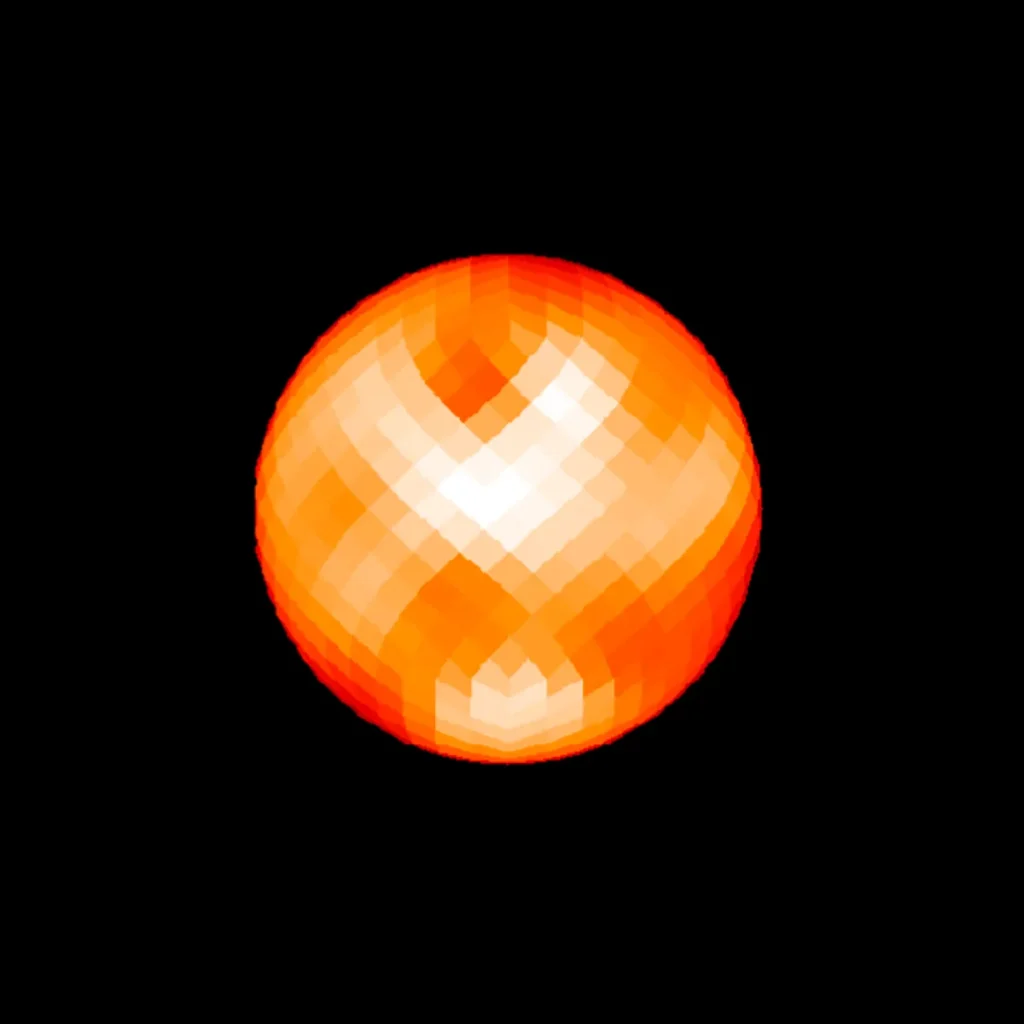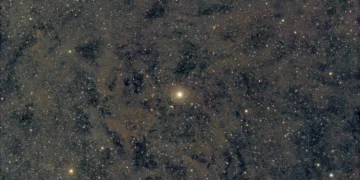The North Star, Polaris, has long served as a guiding light for travelers and astronomers alike. Known for its steadfast position in the northern sky, Polaris has been invaluable for navigation and understanding celestial mechanics. However, recent observations reveal that this familiar star is far more dynamic than we once thought. Utilizing the CHARA Array at Mount Wilson, a team of astronomers has uncovered new, unexpected features on Polaris, including a spotted surface and a detailed view of its complex stellar system.
Why Polaris is So Special

Polaris holds a unique position in both science and culture. Known as a Cepheid variable star, Polaris undergoes periodic changes in brightness, a phenomenon directly linked to its size and luminosity. These variations have made Polaris and similar stars essential tools for measuring astronomical distances. By observing the changes in brightness, astronomers can determine a Cepheid’s intrinsic luminosity, which allows them to calculate its distance from Earth. This property has established Cepheid stars as “cosmic yardsticks,” helping scientists map distant galaxies and refine the scale of the universe.
For centuries, Polaris’s steady position and predictable variability made it an ideal reference point for both navigation and cosmic measurements. Polaris is also the closest Cepheid variable to Earth, situated approximately 448 light-years away, making it an ideal target for close-up study. Despite being well-known, Polaris still holds many secrets that only modern observational technology can unveil.
CHARA Array Observations Bring Polaris into Focus
Thanks to the CHARA Array, an innovative telescope system located at Mount Wilson in California, astronomers have achieved an unprecedented close-up view of Polaris. This array utilizes interferometry, combining the power of multiple telescopes to create a composite image with a level of detail that individual telescopes can’t provide. This technology has allowed researchers to observe Polaris with remarkable clarity, capturing details that were once impossible to detect.
One of the most surprising discoveries was the presence of large, bright, and dark spots across Polaris’s surface, a feature referred to as a “mottled” appearance. According to Gail Schaefer, director of the CHARA Array, these spots are dynamic, changing over time in size and location, indicating active regions on Polaris that could be influenced by magnetic fields or other energetic processes. Schaefer noted that observing such spots on a Cepheid star opens new possibilities for understanding surface activity on massive stars, especially since spotted surfaces are typically associated with smaller, cooler stars.
The Spotted Surface and Its Implications for Stellar Activity
The presence of bright and dark spots on Polaris’s surface is significant, as it challenges our understanding of Cepheid variables. On smaller stars, spots are generally caused by magnetic activity similar to sunspots on our Sun. However, observing such spots on a massive Cepheid variable like Polaris suggests a more complex and possibly unique stellar environment. The spots could indicate intense magnetic fields or turbulent processes within Polaris that affect its luminosity and surface temperature.
For astronomers, studying these surface features provides valuable data on how large, pulsating stars like Polaris operate. As these stars age, they go through significant changes, including fluctuations in size and brightness. Understanding the cause and behavior of these spots could reveal more about the life cycles of massive stars, shedding light on similar Cepheid variables in distant galaxies and improving our measurement of cosmic distances. Furthermore, if magnetic fields are indeed responsible, it raises questions about the magnetic dynamics of Cepheids and how these processes might influence other stars in the later stages of evolution.
Mass and Orbit: Uncovering Polaris’s Binary Nature
Another groundbreaking aspect of the CHARA Array’s observations is the precise measurement of Polaris’s mass and the orbit of its companion star. Earlier estimates of Polaris’s mass ranged from 3.5 to 5 solar masses, but CHARA’s observations have provided a more refined measurement of about 5.1 solar masses. This places Polaris firmly within the expected mass range for Cepheid variables, reinforcing our understanding of its evolutionary stage.
The discovery of a companion star orbiting Polaris at a distance roughly equivalent to our solar system’s outer planets has added a new layer of complexity to this celestial giant. With an orbital period of around 30 years, this companion plays an influential role in Polaris’s behavior and possibly its luminosity changes. As binary star systems interact, the gravitational forces between them can impact each star’s rotation and surface activity, which may explain some of the changes observed on Polaris’s surface.
Studying the interaction between Polaris and its companion is not only essential for understanding Polaris itself but also provides insights into how binary systems influence each other’s evolution. Binary star systems are common in the universe, and understanding their dynamics helps astronomers make sense of how stars develop, change, and sometimes merge over time.
What This Means for Future Observations
The CHARA Array’s detailed observations represent a significant step forward in our ability to study Cepheid variables and similar stars. However, the study of Polaris is far from complete. John Monnier, an astrophysicist involved in the study, emphasized the need for continued monitoring to better understand the underlying mechanisms driving Polaris’s surface activity. By observing Polaris over extended periods, scientists hope to identify patterns or cycles in the spots’ appearance and disappearance, which could reveal whether this behavior is unique to Polaris or common among Cepheid variables.
Additionally, future observations could offer more precise data on the influence of Polaris’s companion star. Understanding how this binary relationship affects Polaris will refine models of stellar evolution, especially for large, pulsating stars nearing the end of their life cycles. Each new insight gained from Polaris not only enhances our knowledge of this specific star but also helps refine our understanding of Cepheid variables and their role as cosmic distance markers.
Polaris as a Benchmark in Astronomy
Polaris’s unique characteristics make it more than just a point of reference in the night sky; it serves as a crucial benchmark in astronomical research. Cepheid variables like Polaris have been instrumental in establishing the cosmic distance ladder, a series of methods used by astronomers to measure distances in space. By calibrating Polaris’s luminosity and pulsation period, astronomers can apply this data to Cepheid variables in other galaxies, creating a reliable method for mapping the universe.
Fine-tuning our understanding of Polaris’s properties, including its mass, surface features, and binary dynamics, will improve the accuracy of this cosmic yardstick. As astronomers continue to refine their measurements, Polaris remains central to our efforts to understand not just our galaxy but the structure of the cosmos itself.
Conclusion: The Continuing Legacy of Polaris
The recent observations of Polaris by the CHARA Array underscore that even familiar celestial objects still have secrets to reveal. The discovery of surface spots, a refined mass measurement, and insights into its binary nature demonstrate the complexities of this iconic star and open up new avenues for research. These findings remind us that in the vastness of space, there is always more to learn—even from the stars that have guided humanity for centuries.
As astronomers continue to study Polaris, they are not only expanding our knowledge of Cepheid variables but also enhancing our understanding of stellar evolution and the architecture of the universe. The North Star, which has served as a symbol of stability, is proving to be a dynamic and evolving object, revealing layers of complexity that enrich our cosmic perspective. This guiding light continues to shine brightly, both as a navigational tool and as a window into the mysteries of the universe, inspiring future generations of astronomers to look up and wonder.



















